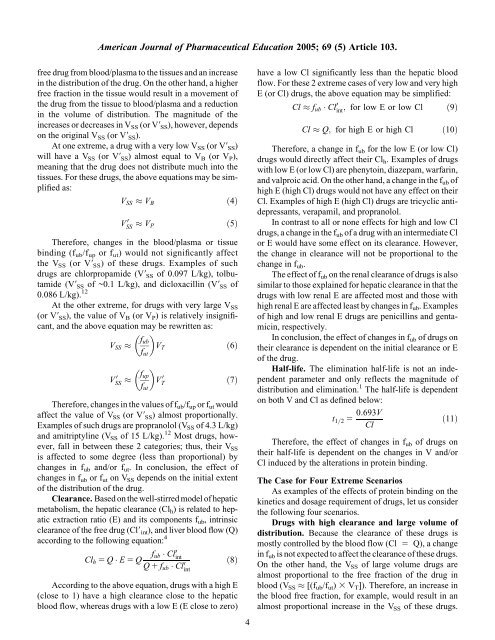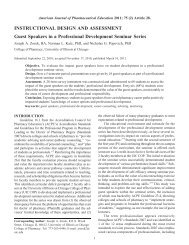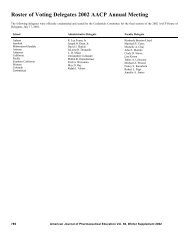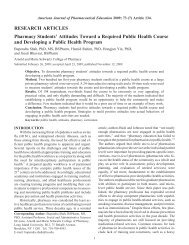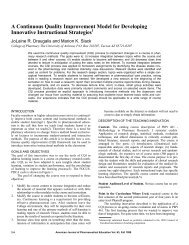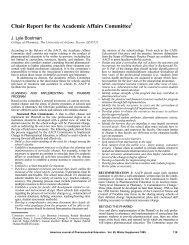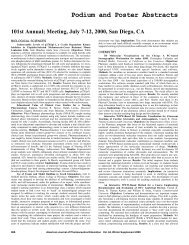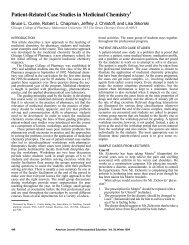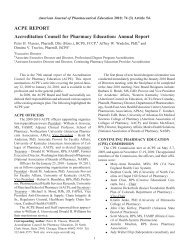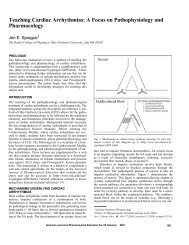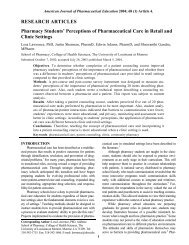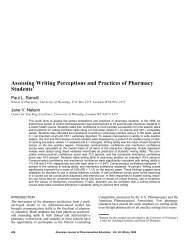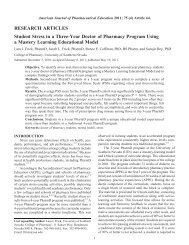TOPICS Role of Protein Binding in Pharmacokinetics - AJPE
TOPICS Role of Protein Binding in Pharmacokinetics - AJPE
TOPICS Role of Protein Binding in Pharmacokinetics - AJPE
You also want an ePaper? Increase the reach of your titles
YUMPU automatically turns print PDFs into web optimized ePapers that Google loves.
American Journal <strong>of</strong> Pharmaceutical Education 2005; 69 (5) Article 103.<br />
free drug from blood/plasma to the tissues and an <strong>in</strong>crease<br />
<strong>in</strong> the distribution <strong>of</strong> the drug. On the other hand, a higher<br />
free fraction <strong>in</strong> the tissue would result <strong>in</strong> a movement <strong>of</strong><br />
the drug from the tissue to blood/plasma and a reduction<br />
<strong>in</strong> the volume <strong>of</strong> distribution. The magnitude <strong>of</strong> the<br />
<strong>in</strong>creases or decreases <strong>in</strong> V SS (or V9 SS ), however, depends<br />
on the orig<strong>in</strong>al V SS (or V9 SS ).<br />
At one extreme, a drug with a very low V SS (or V9 SS )<br />
will have a V SS (or V9 SS ) almost equal to V B (or V P ),<br />
mean<strong>in</strong>g that the drug does not distribute much <strong>in</strong>to the<br />
tissues. For these drugs, the above equations may be simplified<br />
as:<br />
V SS V B<br />
ð4Þ<br />
V 0 SS V P<br />
ð5Þ<br />
Therefore, changes <strong>in</strong> the blood/plasma or tissue<br />
b<strong>in</strong>d<strong>in</strong>g (f ub /f up or f ut ) would not significantly affect<br />
the V SS (or V9 SS ) <strong>of</strong> these drugs. Examples <strong>of</strong> such<br />
drugs are chlorpropamide (V9 SS <strong>of</strong> 0.097 L/kg), tolbutamide<br />
(V9 SS <strong>of</strong> ~0.1 L/kg), and dicloxacill<strong>in</strong> (V9 SS <strong>of</strong><br />
0.086 L/kg). 12<br />
At the other extreme, for drugs with very large V SS<br />
(or V9 SS ), the value <strong>of</strong> V B (or V P ) is relatively <strong>in</strong>significant,<br />
and the above equation may be rewritten as:<br />
<br />
V SS <br />
f <br />
ub<br />
V T<br />
ð6Þ<br />
f ut<br />
V 0 SS <br />
<br />
f <br />
up<br />
VT<br />
0 f ut<br />
ð7Þ<br />
Therefore, changes <strong>in</strong> the values <strong>of</strong> f ub /f up or f ut would<br />
affect the value <strong>of</strong> V SS (or V9 SS ) almost proportionally.<br />
Examples <strong>of</strong> such drugs are propranolol (V SS <strong>of</strong> 4.3 L/kg)<br />
and amitriptyl<strong>in</strong>e (V SS <strong>of</strong> 15 L/kg). 12 Most drugs, however,<br />
fall <strong>in</strong> between these 2 categories; thus, their V SS<br />
is affected to some degree (less than proportional) by<br />
changes <strong>in</strong> f ub and/or f ut . In conclusion, the effect <strong>of</strong><br />
changes <strong>in</strong> f ub or f ut on V SS depends on the <strong>in</strong>itial extent<br />
<strong>of</strong> the distribution <strong>of</strong> the drug.<br />
Clearance. Based on the well-stirred model <strong>of</strong> hepatic<br />
metabolism, the hepatic clearance (Cl h ) is related to hepatic<br />
extraction ratio (E) and its components f ub , <strong>in</strong>tr<strong>in</strong>sic<br />
clearance <strong>of</strong> the free drug (Cl9 <strong>in</strong>t ), and liver blood flow (Q)<br />
accord<strong>in</strong>g to the follow<strong>in</strong>g equation: 4<br />
Cl h 5 Q E 5 Q<br />
f ub Cl<strong>in</strong>t<br />
0<br />
Q 1 f ub Cl<strong>in</strong>t<br />
0 ð8Þ<br />
Accord<strong>in</strong>g to the above equation, drugs with a high E<br />
(close to 1) have a high clearance close to the hepatic<br />
blood flow, whereas drugs with a low E (E close to zero)<br />
4<br />
have a low Cl significantly less than the hepatic blood<br />
flow. For these 2 extreme cases <strong>of</strong> very low and very high<br />
E (or Cl) drugs, the above equation may be simplified:<br />
Cl f ub Cl<strong>in</strong>t 0 ; for low E or low Cl ð9Þ<br />
Cl Q; for high E or high Cl<br />
ð10Þ<br />
Therefore, a change <strong>in</strong> f ub for the low E (or low Cl)<br />
drugs would directly affect their Cl h . Examples <strong>of</strong> drugs<br />
with low E (or low Cl) are phenyto<strong>in</strong>, diazepam, warfar<strong>in</strong>,<br />
and valproic acid. On the other hand, a change <strong>in</strong> the f ub <strong>of</strong><br />
high E (high Cl) drugs would not have any effect on their<br />
Cl. Examples <strong>of</strong> high E (high Cl) drugs are tricyclic antidepressants,<br />
verapamil, and propranolol.<br />
In contrast to all or none effects for high and low Cl<br />
drugs, a change <strong>in</strong> the f ub <strong>of</strong> a drug with an <strong>in</strong>termediate Cl<br />
or E would have some effect on its clearance. However,<br />
the change <strong>in</strong> clearance will not be proportional to the<br />
change <strong>in</strong> f ub .<br />
The effect <strong>of</strong> f ub on the renal clearance <strong>of</strong> drugs is also<br />
similar to those expla<strong>in</strong>ed for hepatic clearance <strong>in</strong> that the<br />
drugs with low renal E are affected most and those with<br />
high renal E are affected least by changes <strong>in</strong> f ub . Examples<br />
<strong>of</strong> high and low renal E drugs are penicill<strong>in</strong>s and gentamic<strong>in</strong>,<br />
respectively.<br />
In conclusion, the effect <strong>of</strong> changes <strong>in</strong> f ub <strong>of</strong> drugs on<br />
their clearance is dependent on the <strong>in</strong>itial clearance or E<br />
<strong>of</strong> the drug.<br />
Half-life. The elim<strong>in</strong>ation half-life is not an <strong>in</strong>dependent<br />
parameter and only reflects the magnitude <strong>of</strong><br />
distribution and elim<strong>in</strong>ation. 1 The half-life is dependent<br />
on both V and Cl as def<strong>in</strong>ed below:<br />
t 1=2 5 0:693V<br />
ð11Þ<br />
Cl<br />
Therefore, the effect <strong>of</strong> changes <strong>in</strong> f ub <strong>of</strong> drugs on<br />
their half-life is dependent on the changes <strong>in</strong> V and/or<br />
Cl <strong>in</strong>duced by the alterations <strong>in</strong> prote<strong>in</strong> b<strong>in</strong>d<strong>in</strong>g.<br />
The Case for Four Extreme Scenarios<br />
As examples <strong>of</strong> the effects <strong>of</strong> prote<strong>in</strong> b<strong>in</strong>d<strong>in</strong>g on the<br />
k<strong>in</strong>etics and dosage requirement <strong>of</strong> drugs, let us consider<br />
the follow<strong>in</strong>g four scenarios.<br />
Drugs with high clearance and large volume <strong>of</strong><br />
distribution. Because the clearance <strong>of</strong> these drugs is<br />
mostly controlled by the blood flow (Cl 5 Q), a change<br />
<strong>in</strong> f ub is not expected to affect the clearance <strong>of</strong> these drugs.<br />
On the other hand, the V SS <strong>of</strong> large volume drugs are<br />
almost proportional to the free fraction <strong>of</strong> the drug <strong>in</strong><br />
blood (V SS [(f ub /f ut ) 3 V T ]). Therefore, an <strong>in</strong>crease <strong>in</strong><br />
the blood free fraction, for example, would result <strong>in</strong> an<br />
almost proportional <strong>in</strong>crease <strong>in</strong> the V SS <strong>of</strong> these drugs.


